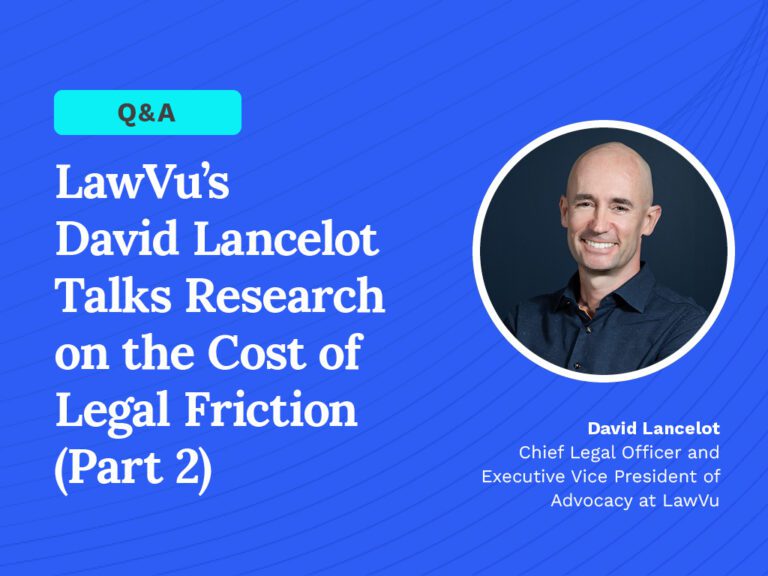LawVu’s David Lancelot Talks Research on the Cost of Legal Friction (Part 2)
October 10, 2025

With 20+ years’ experience leading international in-house legal teams, David Lancelot is Chief Legal Officer and Executive Vice President of Advocacy at LawVu. He is also an Adjunct Professor at the University of Florida College of Law, teaching International In-House Legal Leadership. Previously, he held senior legal leadership roles across technology, ecommerce, and media.
This Q and A is the second part of a three-part conversation with David Lancelot, Chief Legal Officer and Executive Vice President of Advocacy at LawVu, about “Legal Friction: The Real Cost to Your Business.” The research is based on an International Data Corporation (IDC) survey of more than 350 business and legal leaders across the United States, the United Kingdom, and Australia. It focuses on the operational drag caused by inefficient legal processes and fragmented workflows within legal teams and between legal and business partners. You can read the first part of the interview here and the third part here.
IDC identifies inefficient communication, sticky interactions with the business, and inconsistent processes as top friction points. How can legal departments improve their internal service delivery model to become more responsive and transparent partners to the business?
David Lancelot: For me, it comes down to transparency, efficiency, and acceleration. Much of that can be solved with what I’d call a legal front door, an intake portal.
Think about it: If you’re flying an airline, you don’t have to wait three days for an agent to confirm your flight; you can check the app. Legal should work the same way. With an intake portal, the business can log requests, view contract updates, track matters, and messages in one place. That cuts down on wasted time and makes the function far more transparent.
Beyond intake, how else can the legal sector utilize technology to enhance transparency and alignment?
David Lancelot: Data is the other big piece. If you can show real-time reporting, charts and dashboards that update automatically, you’re telling the story in the same way sales, marketing, or finance already do. That’s far more powerful than pulling numbers from an Excel sheet once a quarter to make a PowerPoint.
However, the ultimate goal extends even further: moving from a reactive to a proactive approach. When I coach GCs and CLOs, I always start with purpose. Legal isn’t just there to spot risks; it’s there to serve as the company’s ethical compass and to drive strategic goals. Once you automate the low-value work, you can start showing how legal actively advances business objectives. That’s how you shift the narrative from the legal department being a cost center to a genuine value driver.
You’ve talked before about the dangers of a “don’t tell legal” culture. Where does that mindset come from, and why is it so risky?
David Lancelot: I’ve seen it firsthand. A team is in a leadership meeting upstairs, and when I go downstairs to another business unit, their lawyers are drowning in email, too busy even to talk. That’s when you start hearing: “If we want to get this done, just don’t tell legal.”
That mindset usually comes from burnout and under-resourcing, and the IDC research supports this. Legal gets overwhelmed, lowers its risk tolerance just to keep things moving, and suddenly the business sees them as a blocker. Leaders start hiding projects from legal because they think it’s the only way to get things done.
From a CFO’s perspective, what does that lack of transparency mean besides increased risk?
David Lancelot: It means uncertainty, and uncertainty is expensive. If a CFO doesn’t know what risks are being managed, what contracts are under control, or where legal bottlenecks sit, they have to assume the worst. That usually means setting aside extra reserves “just in case.” Money that could fuel growth ends up being parked in contingency funds instead, simply because legal lacks the operational rigor and visibility to inspire confidence.
Only 41% of legal respondents reported having access to comprehensive data to evaluate their teams effectively. How does the lack of accessible data and actionable insights within the legal function contribute to inefficiency or poor decision-making?
David Lancelot: Without data, legal is stuck with anecdotal evidence. Leaders hear “legal is too slow” all the time, but they can’t measure it. There’s no benchmark, no system, no operational mindset. Other departments, such as sales, HR, and marketing, have optimized processes and dashboards to demonstrate their impact. Legal often doesn’t.
That absence of data also feeds the cost-center narrative. If the only metric you track is spend on outside counsel, then your story is: “We’re expensive, but we’re trying to be less expensive.” That’s not compelling. What leadership really wants to hear is: “We’re helping you achieve your strategic goals, and here’s the proof.” But without data, you can’t have that conversation.
Why do you think legal is so often overlooked, even when inefficiency is as high as 11% of revenue?
David Lancelot: In any other function, 11% inefficiency would be a five-alarm fire. But legal doesn’t raise alarms because nobody can see it. There’s no dashboard. No KPIs. No transparency. So executives just chalk it up to “that’s how legal works.”
It also comes down to trust. CFOs often don’t trust legal to ask for the right resources. They hear, “We need more lawyers, more spend, more external counsel.” What they should be hearing is, “We don’t need more, we need different: operations, technology, smarter processes, and policies that eliminate unnecessary work.” That’s how you build trust and start speaking the same language as the rest of the business.
Technology is positioned as the core enabler of transformation. In fact, 99% of legal respondents said that legal technology solutions improved their team’s internal reputation. What types of legal tech investments have yielded the most measurable impact?
David Lancelot: Reporting was the one that blew my mind. As the GC of a complex business, I’d try to gather data from scattered legacy systems, or worse, no systems at all. I’d survey my team, try to crunch numbers in Excel, then spend hours wrestling with pivot tables or PowerPoint. Maybe I could manage that once a quarter, if I were lucky. More likely, once a year.
Meanwhile, marketing just pulls up a HubSpot dashboard. Sales has Salesforce. HR has Workday. Product and IT teams have JIRA. Legal? We’re still cobbling together spreadsheets. That creates enormous friction and keeps us from managing the function in real time.
The biggest impact occurs when you can transition from a patchwork approach to a unified platform that encompasses intake, matter management, and reporting. Once you have that, you can finally operate with the same transparency and rigor as your peers, and that’s when legal starts being seen as a driver of business value, not just a cost.
Must read intelligence for general counsel
Subscribe to the Daily Updates newsletter to be at the forefront of best practices and the latest legal news.
Daily Updates
Sign up for our free daily newsletter for the latest news and business legal developments.




